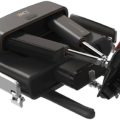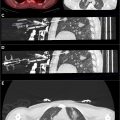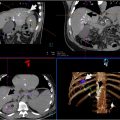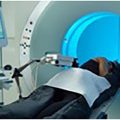The integration of robotic systems in image-guided trans-arterial interventions has revolutionized the field of Interventional Radiology (IR), offering enhanced precision, safety, and efficiency. These advancements are particularly impactful for acute conditions such as stroke, pulmonary embolism, and STEMI, where timely intervention is critical. Robotic platforms like the CorPath GRX and Magellan allow for remote navigation and catheter-based interventions, making it possible to extend specialized services to remote and underserved areas. These systems reduce radiation exposure for operators and enable safer, more complex procedures such as neurovascular interventions, pulmonary embolism treatment, and trans-arterial chemoembolization. By allowing specialists to control procedures remotely, robotic systems can dramatically improve outcomes in regions lacking immediate access to expert care for acute diseases. However, challenges such as high costs, the need for robust telecommunication infrastructure, and the absence of tactile feedback still exist. Future innovations, including untethered micro-robots and MR-guided robotics, hold promise for addressing these limitations. As these technologies evolve, robotic systems are expected to play a vital role in improving access to life-saving interventions in remote areas, transforming how trans-arterial procedures for acute diseases are performed while reducing risks to both patients and operators.
Introduction
Interventional Radiology (IR) has dramatically evolved with advancements in imaging technologies, allowing for the development of minimally invasive procedures that would not be possible without precise imaging techniques. Trans-arterial interventions, which involve navigating the arterial system to either image or treat a condition, have significantly benefited from these technological advances. Robotics has promising role in improving the precision and safety of such procedures. This review explores the current and future role of robotic systems in trans-arterial interventions.
Evolution of robotics in endovascular procedures
The use of robotic systems in endovascular interventions began with the development of devices aimed at improving catheter navigation and reducing radiation exposure during procedures. For example, the Sensei X system from Hansen Medical was one of the first robotic systems approved by the FDA. , This system provided a remote-control interface, allowing interventional radiologists to manipulate catheters with a joystick. This early robotic platform enabled more precise catheter movement in procedures such as cardiac electrophysiology and endovascular aneurysm repair.
Although these earlier systems significantly enhanced stability and precision, their optimal function was impaired by some factors such as large catheters, like the 14 Fr used in the Sensei system create difficulties in navigating smaller vessels, restricting their application in complex vasculature. This challenge led to the development of next-generation systems, such as the Magellan robotic system ( Fig. 1 A), designed for smaller caliber arteries. With catheters ranging from 6 to 10 Fr, the Magellan system (developed by Hansen Medical) offers greater flexibility and improved navigation through peripheral arterial systems. The Magellan robotic system has shown success in various procedures, including uterine artery embolization and fenestrated endovascular aneurysm repair and trans-arterial chemoembolization.

Navigation systems and imaging modalities
Endovascular robotics are equipped with various navigation systems that can be magnetic, optical, or impedance-based. Initially, these systems were designed for electrophysiological studies, but over time, they have been adapted for broader endovascular use. These navigation systems aim to minimize procedural complications, shorten procedure times, and reduce the amount of contrast agent and radiation exposure. Systems like the Intraoperative Positioning System (IOPS) utilize electromagnetic signals to assist in catheter tracking during procedures, although this is not considered a robotic system.
In addition to fluoroscopy, robotics can also benefit from advanced imaging techniques such CTA which provides a 3D visualization of the vasculature and enhances the precision and safety of robotic navigation during complex interventions.
Current endovascular robotic systems for trans-arterial interventions
One of the most advanced robotic platforms currently used in endovascular interventions is the CorPath GRX system ( Fig. 1 B). This system provides control over guidewires, balloon/stent catheters, and guiding catheters, offering enhanced procedural automation. The CorPath GRX has been applied in several endovascular procedures, including peripheral vascular interventions, neurovascular interventions and percutaneous coronary interventions. Its flexibility allows for the use of off-the-shelf catheters, reducing costs compared to dedicated robotic catheters. In a study involving 117 patients with unruptured cerebral aneurysms, the CorPath GRX system demonstrated a 94% success rate in robot-assisted embolization procedures, showing its capability in complex interventions. The system also reduces operator radiation exposure by allowing remote operation from a control room.
The R-One robotic platform (Robocath) is another promising system designed to assist in PCI procedures ( Fig. 1 C). It has shown high success rates in clinical trials, with a 100% clinical success rate and a significant reduction in radiation exposure for operators. Similar to CorPath GRX, the R-One utilizes off-the-shelf guidewires and balloon/stent catheters, providing cost-effective solutions for hospitals.
The LIBERTY® Robotic System is a new single-use endovascular robotic system that features a robotic remote controller and a robotic arm ( Fig. 1 D). It is currently undergoing clinical trials and has demonstrated accessibility to visceral vessel branches in a porcine model.
Benefits and limitations of robotic systems
Robotic platforms offer several advantages in trans-arterial interventions, including increased precision in catheter navigation, enhanced stability when traversing tortuous vascular anatomy, and reduced radiation exposure for operators. These systems also promising to improve cannulation success rates in difficult-to-access vessels and allow for more complex procedures to be performed with greater safety.
However, several challenges remain. The high cost of installation and maintenance is a significant barrier to widespread adoption. Systems like the Magellan and CorPath GRX have initial costs ranging from $480,000 to $1.5M, with additional costs for disposable components like robotic catheters. Another drawback is the lack of tactile feedback, which can make it difficult for operators to feel resistance during catheter navigation. While next-generation systems are addressing these issues, such as through the development of intelligent soft-body robots, current platforms still require further innovation.
Future prospects
The future of robotic systems in trans-arterial interventions is promising, with ongoing research focusing on untethered robotic devices and magnetic resonance (MR)-guided systems. MR-guided robotics offers the potential for superior 3D visualization of vasculature, which could enhance the safety and precision of complex interventions. Additionally, companies like Stereotaxis are developing platforms like the Genesis RMN system, which uses magnetic fields for catheter manipulation, offering precise control in challenging vascular anatomies.
The incorporation of advanced imaging modalities, such as CTA and magnetic resonance angiography is another area of focus. These imaging techniques allow for 3D vascular reconstruction and real-time intraoperative visualization, which could further enhance the effectiveness of robotic systems. The ideal and most promising approach would not only involve using robotic systems to navigate the vasculature, but also controlling these systems with augmented reality. Integrating multidimensional input into a single system, while being able to monitor the patient’s condition, communicate findings with other team members and control the robotic system during the procedure, would offer significant advantages.
Small-scale, untethered mobile micro or nano robots for use in endovascular interventions, offering solutions to the limitations of current catheter/wire based devices(tethered). Micro-robots could address challenges related to navigation within complex vascular anatomies, which demand high levels of precision and dexterity from medical professionals. For example, emerging robotic designs, like ferromagnetic soft robots may provide complex procedures, especially in delicate areas like the cerebral vasculature and provide medications by delivering therapeutic agents or directly interacting with bleeding or blood clots. However, practical concerns remain regarding their rapid deployment, control, and safety, particularly in emergency situations like heart attacks or strokes, where time is critical. Also, their development faces significant hurdles, such as ensuring reliable control, safe navigation, and retrieval within the bloodstream. Additionally, challenges such as biocompatibility, preventing thrombosis, and ensuring safe degradation of robots within the body are critical points needs to be addressed. Designing these robots to be compatible with existing medical imaging and tracking technologies is also crucial. Collaboration between engineers and physicians is essential to align the design of these devices with clinical needs.
While advancements have been made, small-scale robotic systems still need significant refinement before they can be widely used in clinical practice. Overcoming these technical, safety, and adoption challenges will be key to integrating these innovations into endovascular interventions.
Conclusion
Robotic systems are promising role in the advancement of trans-arterial interventions by enhancing precision, improving procedural safety, and reducing radiation exposure. Despite the current limitations, including cost and lack of tactile feedback, ongoing technological advancements hold great promise for the future. As robotic systems continue to evolve, they are likely to become an integral part of interventional radiology, enabling more complex and safer procedures with reduced operator risk.
Declaration of competing interest
Nariman Nezami is a member of the Advisory Board for Boston Scientific and CAPS Medical, serves as a Consultant and Speaker for Boston Scientific, and involved in Safety Monitoring for Microbot Medical.
Acknowledgments
None.
References
Stay updated, free articles. Join our Telegram channel

Full access? Get Clinical Tree








